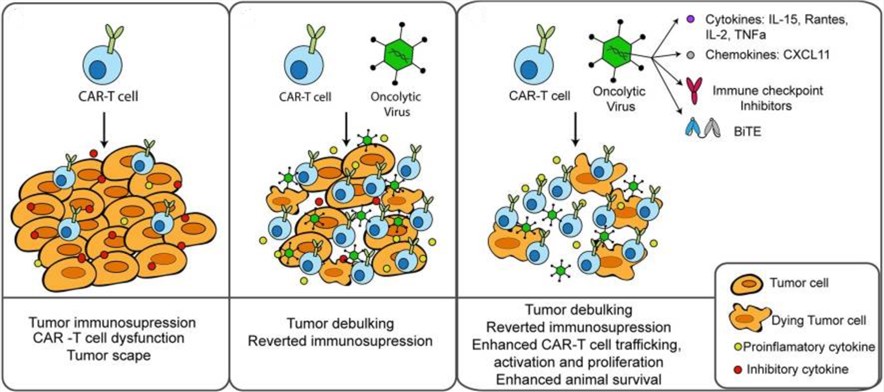Oncolytic Virus Combination Therapies-with T Cell Adoptive Immunotherapy
The adoptive transfer of chimeric antigen receptor (CAR)-modified T cells is a milestone breakthrough in the history of cancer treatment and has completely changed the method of tumor treatment. Especially for some hematological malignancies, patients with leukemia and lymphoma in clinical trials have achieved a long-term unprecedented complete response rate. However, CAR-T has a limited effect on solid cancer, which may be caused by the heterogeneity of immunosuppressive tumor microenvironment and antigen expression. Oncolytic virus (OV) has the potential to cooperate with CAR-T cells and can be used to treat solid tumors. In addition, the virus can be further modified to selectively deliver therapeutic transgenes to the tumor microenvironment, which can enhance the effector function of tumor-specific T cells.
 Fig.1 Mechanisms combination of CAR-T cells and oncolytic virus for the treatment of solid tumors. (Guedan, 2018)
Fig.1 Mechanisms combination of CAR-T cells and oncolytic virus for the treatment of solid tumors. (Guedan, 2018)
Challenges of CAR-T Cell Therapy for Tumor
Although CAR-T cells have achieved amazing results in patients with hematological malignancies, this method has little effect on solid tumor patients. Although some clinical trials have shown that CAR-T cells can infiltrate tumor masses and play an antigen-directed role. However, with very few exceptions, the reactions observed in patients with solid tumors are weak and transient. To solve this problem, CAR-T cells need to overcome some obstacles.
- First, CAR-T cells must be transported from the blood to the tumor, infiltrate the tumor mass, and be able to survive and maintain its effector function in the highly immunosuppressive and matrix-rich tumor microenvironment.
- Then, CAR-T cells need to eliminate the entire cancer cells, which is very difficult because of the heterogeneity of antigen expression in cancer cells and the inherent plasticity of tumors that may lead to tumor escape.
- Finally, CAR-T cells are living drugs that can cause a violent anti-tumor response, but can also induce significant toxicity. Therefore, new methods to enhance the therapeutic effect in patients with solid tumors must focus on enhancing the efficacy without increasing toxicity.
The development of synthetic biology, T cell immunology and gene editing technology has promoted the performance of a new generation of CAR-T cells and is expected to overcome some obstacles encountered in the treatment of solid tumors. However, CAR-T cell therapy alone is still difficult to induce a complete response in most cancers. Using CAR-T cells in combination with other cancer treatment methods that have different mechanisms of action and synergistic effects with T cells can reduce tumor escape and increase the success rate of CAR-T cell therapy. With the emergence of new therapies, a reasonable combination needs to be tested based on an understanding of the mechanism of tumor resistance to CAR-T cells.
Combining CAR-T Cells and Oncolytic Viruses for Tumor Treatment
OV therapy is an idea to treat cancer through the inherent oncolytic activity of the virus. These viruses can recognize some characteristics of cancer cells that are different from normal cells and selectively replicate in cancer cells. OV mediates its anti-tumor effect through a dual mechanism of action, including direct lysis of tumor cells and induction of anti-cancer adaptive immunity. Also, OV can be further modified to selectively deliver therapeutic transgenes to the tumor microenvironment to enhance its anti-tumor efficacy or enhance anti-tumor immune response. All these characteristics make OV an excellent potential partner for synergy with emerging immunotherapy.
Currently, many research teams have begun to test different genetically modified oncolytic virus combined with CAR-T cells at the preclinical level. The therapeutic tests of animal tumor models are as expected, and all these combinations of CAR-T cells and equipped OVs can enhance tumor control and prolong survival compared to each drug as a monotherapy. After adding therapeutic gene delivery, CAR-T cells combined with OV binding IL-2 and TNF-a can simultaneously control the primary tumor and tumor metastasis. Loading OV onto tumor-specific T cells (by adhering to the surface of T cells) can protect the virus from neutralizing antibodies, while maintaining anti-tumor efficacy after being released in the tumor microenvironment. OV tumor delivery of CAR-T cells can enhance the delivery of the virus to the tumor, and subsequent oncolysis can attract more CAR-T cells and establish a positive feedback loop.
Reference
- Guedan, S.; Alemany, R. CAR-T cells and oncolytic viruses: joining forces to overcome the solid tumor challenge. Frontiers in immunology. 2018, 9: 2460.
